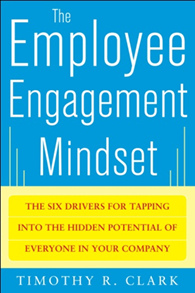By Timothy R. Clark
How do you learn engagement from someone who’s disengaged?
You don’t. That’s like trying to learn French from a Spanish teacher. People simply can’t teach you what they don’t know.
So we decided that the key to understanding high engagement was to study the highly engaged. We studied 150 highly engaged employees in 13 different industries and 50 different organizations, from aerospace and health care to technology and media.
Do they behave in consistent ways? The answer is a resounding yes! Here is what we found:
- Highly engaged employees take primary responsibility for their own engagement. When surveyed, 99 percent of highly engaged employees report that they take personal and primary responsibility for their own engagement. It’s a stunning and largely ignored fact. The highly engaged expect the organization to play a support role. The highly disengaged expect the organization to play a primary role. While most highly engaged employees embrace an employee-centered model of engagement (meaning “I own it; it’s up to me; I’m responsible for my own engagement”), most disengaged employees follow an employer-centered model (meaning “It’s my manager’s or the organization’s job to keep me engaged”). In sharp contrast, the highly engaged don’t wait around for the organization to engage them. They take deliberate steps to engage themselves.
- Highly engaged employees feel the least entitled. Highly engaged employees understand they must dynamically manage their employability on an ongoing basis. They are far less predisposed to worry about what the organization owes them. They believe that high performance speaks for itself and that it will be recognized in any setting. It’s rather stunning, but most of the highly engaged individuals we studied think the concept of a “secure job” is a silly concept. They look at others who believe in such a notion as foolhardy. It’s not necessarily that we are going to become a world of temp workers, but a simple acknowledgment that no one and no organization has the power to grant true job security.
- Highly engaged employees engage customers. Highly engaged employees can’t help but reveal themselves to customers. They project and infect customers with the contagion of their own engagement. Unfortunately, the opposite is also true of disengaged employees. Ultimately, an organization’s brand promise is kept or broken by the employee — the real and ultimate face of the company. Highly engaged employees make the customer experience. Disengaged employees break it. Whatever is inside the employee is sure to come out and infl uence the customer. Employees always reveal their level of engagement at the customer interface.
- Highly engaged employees remain highly engaged almost anywhere. Highly engaged employees are amazingly agnostic to their organizational environment. We found highly engaged people in all kinds of organizational settings and environments: corporations, governments, hospitals, schools, nonprofi ts. It didn’t matter. They demonstrate agility and adaptability and recognize that organizational conditions are subject to market conditions and the business cycle. Their high engagement is portable; they take it with them. It’s both a mindset and a skill set. They create their own weather.
- Highly engaged employees apply six behavioral drivers. Individuals who take personal and primary responsibility for their own engagement consistently apply six behavioral drivers: connecting, shaping, learning, stretching, achieving, and contributing. The ongoing process of applying these drivers allows them to sustain high levels of engagement over time.
Highly engaged must take the lead
Don’t misunderstand. We’re not saying that leaders and organizations shouldn’t help engage their employees.
They should! Extrinsic motivators help drive engagement, and leaders play a vital role in fostering conditions that boost engagement, such as creating a dynamic culture, developing good leadership, creating a compelling strategy and vision, aligning reward and recognition systems, and providing ample resources.
We are saying, however, that highly engaged employees must take primary responsibility. They must take the lead.
As an individual, you’re responsible for enabling behavior. If both elements come together, the result is a highly engaged individual. It’s important to understand both factors and how they reinforce each other.
“The employee’s role is primary”
And it’s critical to recognize a significant finding from our research about highly engaged employees: even in poorly performing organizations with lousy work conditions, limited resources, and few opportunities, those who are highly engaged still take responsibility and own their own engagement.
Here’s the principle: Organizational conditions that create extrinsic motivation are important, but never enough. The employee’s role is primary. The organizagtion’s role is secondary.
To maintain high engagement, you’ve got to take action. You’ve got to apply the six drivers and create your own engagement.
Excerpted from The Employee Engagement Mindset, by Timothy Clark. © 2012, McGraw-Hill Professional. Reprinted with permission of the publisher.
